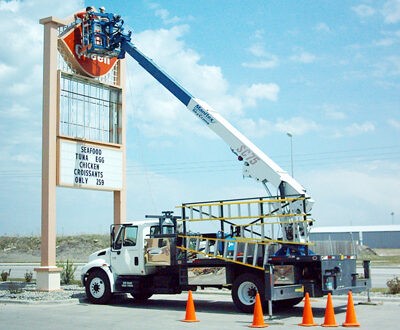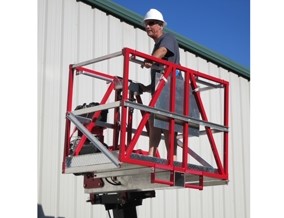The Challenges of Sign Installation
Sign installation is widely diverse in the techniques employed to keep your sign safely where you installed it. The installation could be as simple as putting a push pin in the wall and hanging the sign on it. Some installations are more complicated especially if you are installing a monument sign or an electric sign.
It could also be as complicated as hiring a crane company or even a helicopter to lift the sign in place. Most commercial cases require permits, insurance, engineering, inspections, and coordination.
 Sign Installation Crane
Sign Installation CranePermits, Permissions, and Inspections
If the signs are to be used indoors for your own or friend’s enjoyment, the government requirements usually are not as strict.
But making commercial signs is another story. For instance, in California, any sign valued at $500.00 or more requires that the installer have a Contractor’s License which also requires posting a Bond, maintaining Liability Insurance, maintaining Workman’s Compensation Insurance, in most cases, getting a permit from the City or County, passing Design Review and Building Department inspections.
Also, various municipalities have design and size restrictions that may be unique to that city or county. Other considerations are for requirements to have a Business License, a Federal Employer’s ID Number and a State Resale Certificate. I wish I could say the requirements are getting easier, but they are not.
If the sign is to be illuminated, you may also need an Underwriter’s Laboratories Label. That UL label can only be applied in a UL listed shop and they must make the sign themselves to UL standards, using UL Listed materials and then get it inspected.
Check Local Authorities to be Sure
Every state has their own ordinances and enforces them differently. So please check the municipalities where your sign is to be installed before going to the expense and time to make it.
Some of these requirements apply to non-illuminated signs as well. Please check with your local authorities prior to making your sign thereby ensuring that you can install it after you make it.
As you can guess, there is a host of hardware and equipment that may be required to hang your sign.
I will expand on these topics and many others in the pages to follow. The plan is to start out with simple installations and build toward more complex situations as we go.
Sign Installation Safety
 Typical Manlift
Typical ManliftAnother consideration as we journey through the topic of sign installation is Safety. Sign Installation can be a very dangerous type of work. There are many OSHA regulations to insure you have a safe working environment.
However, the worker is much more in danger of very serious or even fatal outcomes resulting from accidents during sign installations. I will discuss this topic in the pages to follow as well as in the tree on Safety. Also, I will mention certifications that may be required for staging, man lifts, cranes, and crane operators.
I will also have pages on Service Work to repair and maintain signs in this section.